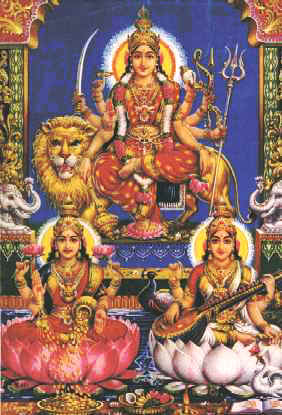|
Quick Links
Select City |
Navratri and Dandiya Open air stages are usually erected and a variety of entertainments enliven the cool nights. In many parts of the country, notably Bengal, Karnataka, Maharashtra and Andhra Pradesh, clay idols depicting Durga finishing off the wicked demon Mahisha are installed. After the celebrations are over on the 10th day, the idols are ceremonially taken to the nearest river, beach or lake and immersed into the waters. In the northern parts of India, people also read Ramayana during this time because it is believed that on the Vijaya Dasami day, Rama returned to Ayodhya Victorious after killing the evil king Ravana. It is considered *auspicious to start new ventures especially on education and other arts on Vijya Dasami day. It is also common in India to see children start their first music or dance or other educational ventures on Vijaya Dasami. We the human beings are prone to exhibit rajasic qualities like anger and hatred which are the menacing manifestations of Durga Devi to destroy the evil. Our interest in music, arts and knowledge are the pleasing vibrations produced by the power of Saraswathi Devi. The pure qualities which include compassion, love, forbearance and sympathy are derived from Laxmi Devi. When we worship Durga, Laxmi and Saraswathi externally in pictures or icons, they are giving physical forms to the subtle potencies that are within them. It is unfortunate that we fail to recognize the importance of the symbolism behind the festivals and celebrations. We are too quick to go after the material aspects of the celebrations instead of focusing on the spiritual message. We seem to look for remedies from outside instead of looking for the answers inside. We ignore the Divinity within and seek the external objects in search of Divinity. There is no need to go in search of the Divinity outside. We must develop firm faith in the Divinity within and turn our attention inward to experience the True Human Nature. What is that we should do during these days of the Navarathri festival? We direct our Itchaa Sakti to direct our mind toward Divinity within. We apply our Kriya Sakti to conduct Dharmic Actions - unselfish service to the humanity. Finally, we turn our Jnaana Sakti to attain the Divine Self. Hindu Festivals and Celebrations constantly remind us our True Human Nature through symbolic messages. The purpose of the celebrations is not for external pleasures but for inward peace and tranquility.
Dandiya and GarbaDandiya and Garba are the featured dances of Navratri
evenings. Navaratri is celebrated for nine consecutive nights in praise of Lord
Rama and Goddess Durga from the end of September to early October. These
originated in the state of Gujarat but is celebrated across India. It is the
longest Hindu festival celebrated all over India. This dance form is actually the staging of a mock-fight between the Goddess and Mahishasura, the mighty demon-king, and is also called "The Sword Dance". Dancers use a pair of colorfully decorated sticks, the sticks represent the sword of Durga. The women wear traditional dresses (colorful embroidered choli, ghagra and bandhani dupattas) dazzling with mirrors and heavy jewelry. The Men also wear traditional cloths such as turbans and kedias. The dancers whirl and move their feet and arms in a choreographed manner to the tune of the music with lots of drum beats. The dhol, dholak, tabla and many other percussion instruments are used for the music and dance. Raas is an important part of Navaratre and extends itself to other festivals related to harvest and crops e.g. Bhangra in Punjab. Difference between Garb and Dandiya:
Garba is performed exclusively by women, men and women join in for Raas Dandiya. The circular movements of Dandiya Raas are much more complex than that of Garba.
|
|
|
|

| |
|
Home |
Frequently Asked Questions |
Jobs |
Advertise | Privacy |
Terms and Conditions |
About Us | Contact Us |



